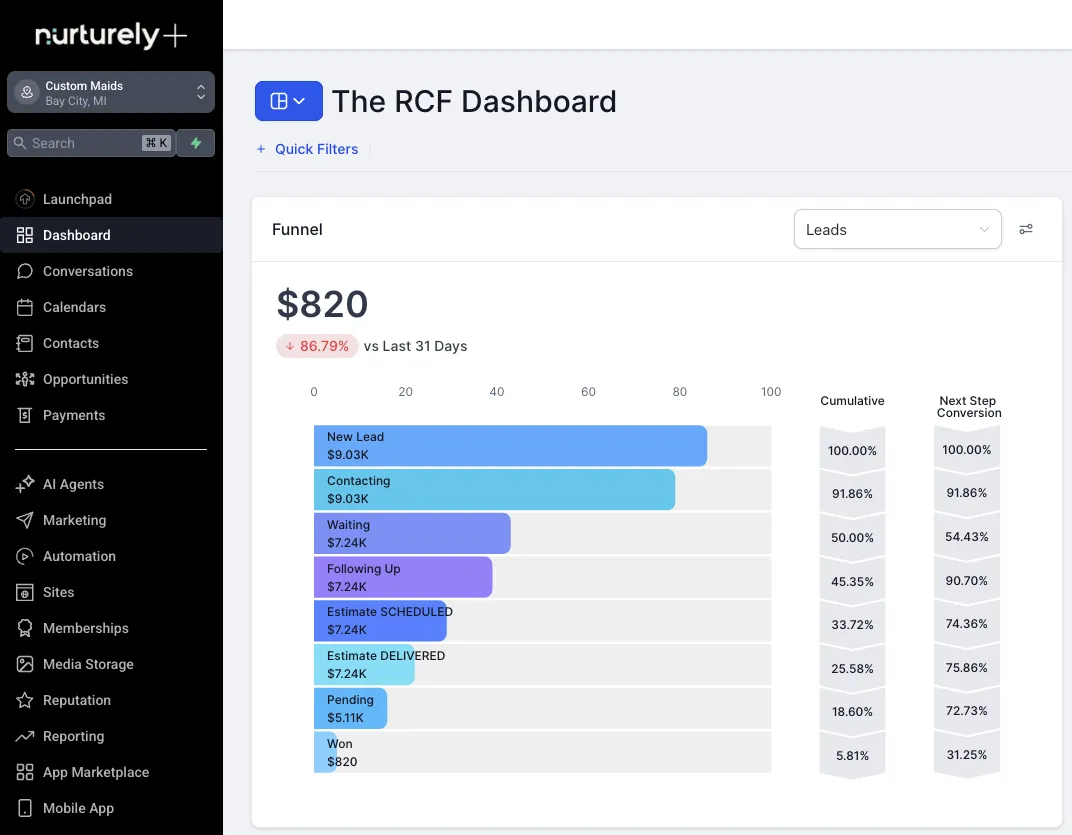How To Lower Customer Acquisition Cost
Lower Customer Acquisition Cost: Proven Strategies to Save
If you want to lower your customer acquisition cost, you first have to know what you’re really spending to get a new customer. This number goes way beyond just your ad spend. It’s a mix of salaries, software subscriptions, and even the cost to produce your creative content—all of which add up to your final CAC.

TABLE OF CONTENTS
Lower Customer Acquisition Cost: Proven Strategies to Save
Understanding Your True Customer Acquisition Cost
How Different Channels Impact Your Budget
A Modern Look at Acquisition Channel Cost-Effectiveness
Capture Every Lead with a Seamless Funnel
Go Way Beyond the Basic Contact Form
Implementing Your Integrated Capture System
Slash Manual Effort with Marketing Automation
Build an Instant Response System
Create Adaptive Nurturing Sequences
Use Automation to Qualify Leads for Sales
Use Analytics to Cut Wasteful Spending
Digging Deeper Than Just the Final CAC
Pinpoint Your Most Valuable Lead Sources
Find Untapped Markets with Geographic Targeting
Testing New Markets Without Breaking the Bank
Optimizing Campaigns for Local Audiences
What’s a Good CAC for My Industry?
How Quickly Can I See My CAC Go Down?
Do I Need a Huge Budget to Lower My CAC?
Is It Better to Focus on Getting New Customers or Keeping Old Ones?
Understanding Your True Customer Acquisition Cost
Before you can start trimming the fat and getting more efficient, you need an honest baseline. I've seen countless businesses make the classic mistake of only tracking direct ad spend. This gives you a dangerously incomplete picture and often leads to bad decisions, like cutting a high-performing channel because it looks expensive, while ignoring the hidden costs bleeding the budget dry elsewhere.
To get a real number, you have to account for all the related expenses. Before we dive into the strategies, it’s worth taking a minute to really understand the fundamental concept of Customer Acquisition Cost and all its moving parts.
The Hidden Costs in Your CAC
A proper CAC calculation pulls in a ton of expenses that most people forget about. Nailing this down is the first step to finding real savings. Make sure your formula includes:
Marketing Team Salaries: The people running your campaigns are a direct acquisition cost.
Sales Team Commissions & Salaries: Anyone involved in closing the deal counts.
Software & Tool Subscriptions: This is your CRM, analytics platforms, design software—any tool touching the marketing and sales process.
Creative & Content Production: The cost of making the ads, blog posts, videos, or other materials you use to attract customers.
Direct Ad Spend: The most obvious cost, but it's just one piece of the puzzle.
Once you total these expenses over a set period and divide by the number of new customers you brought in, you get your true CAC. This is the benchmark you need to start making smart changes.
The goal is to build a financial model where the lifetime value (LTV) of a customer is way higher than what you spent to get them. A 3:1 LTV-to-CAC ratio is widely seen as a healthy benchmark for sustainable growth.
How Different Channels Impact Your Budget
Not all acquisition channels are created equal. Some are incredibly efficient, while others can become a money pit if you don't manage them closely. Knowing the difference is how you allocate your budget like a pro.
Take a look at this chart. It visualizes the average customer acquisition cost across three of the most common digital marketing channels.
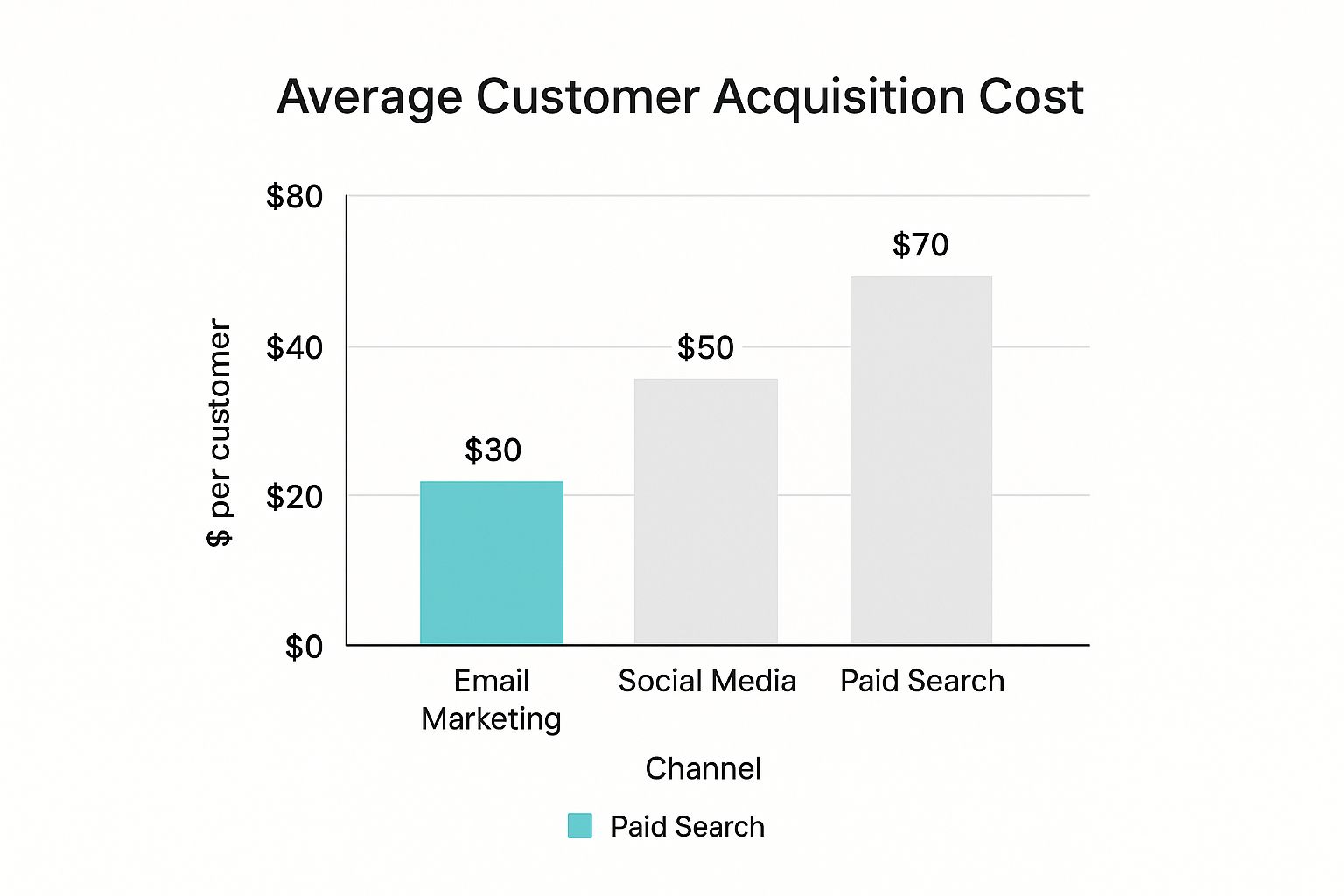
The data tells a clear story: email marketing is by far the most cost-effective channel, while paid search requires the biggest investment to land a single customer.
This is a powerful insight. If your business is leaning heavily on paid search, shifting even a small slice of that budget toward building a solid email list could slash your overall CAC. This isn't about ditching channels, but about optimizing your mix.
A Modern Look at Acquisition Channel Cost-Effectiveness
To put this in perspective, let's break down how traditional channels stack up against their modern digital counterparts. The game has changed, and where you put your money matters more than ever.

This table makes it obvious: digital channels like Social Media, SEO, and Email not only offer a lower CAC but also give you far better targeting and scalability. While traditional methods have their place, the real ROI today is found online.
Each channel plays a unique role in guiding someone from stranger to customer. Knowing how to map that out is critical. For a deeper look at how all these pieces fit together, check out our guide on effective customer journey management.
Ultimately, when you calculate your true CAC and analyze channel performance, you stop guessing and start knowing. This data-driven approach shows you exactly where your money is going and gives you the power to make surgical cuts that lower acquisition costs without hurting your growth.
Capture Every Lead with a Seamless Funnel
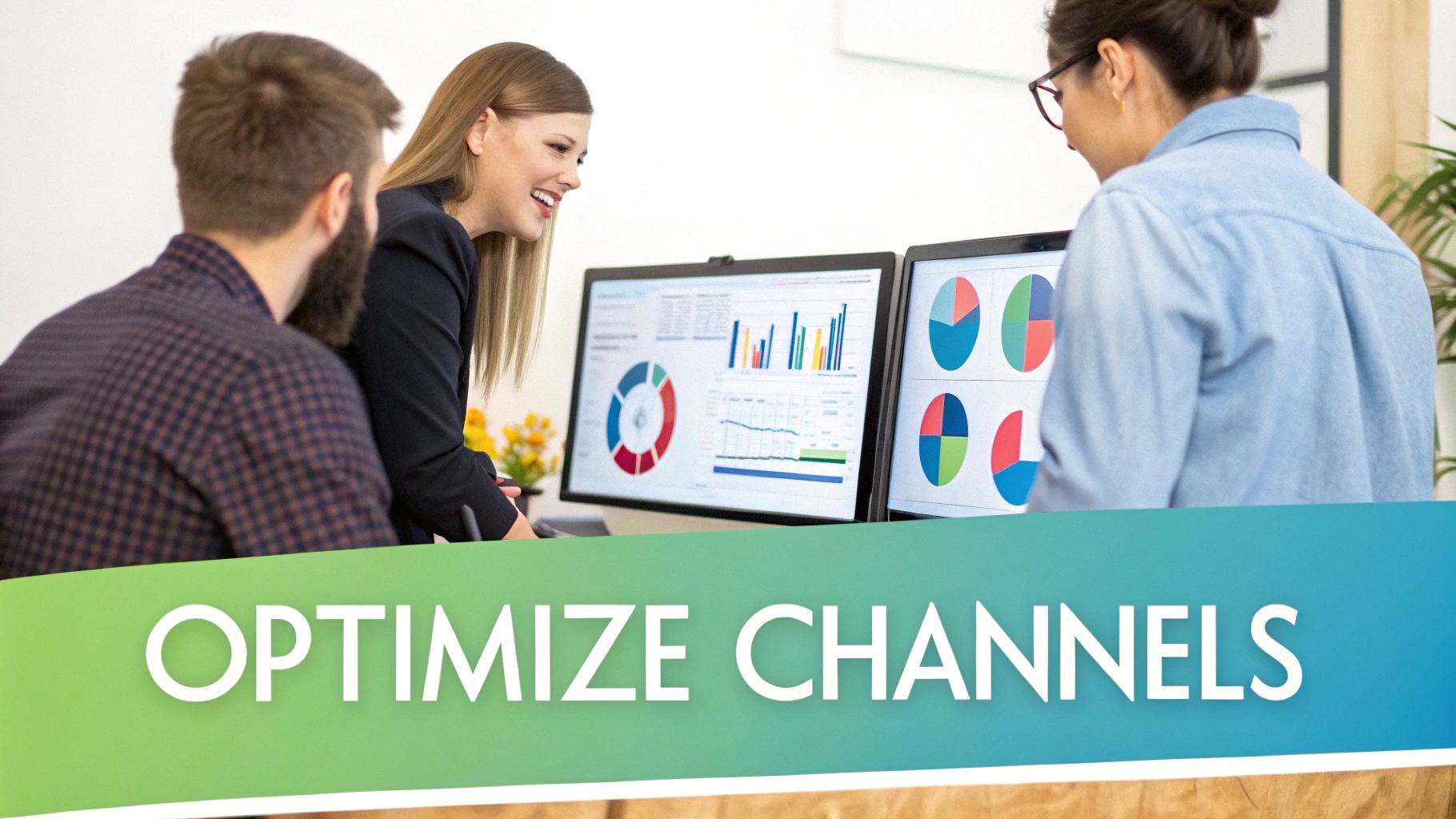
Here’s a hard truth: the fastest way to lower your customer acquisition cost is to stop bleeding out the leads you already paid for. Every ad click, every website visit, every social media impression—it all costs you money. When a potential customer shows even a flicker of interest but has no dead-simple way to connect, that investment vanishes.
This friction is the silent killer of your marketing budget.
Think about a local plumbing company. They might spend thousands on a professional vehicle wrap that gets eyeballs all over town. If the only call to action is a phone number, they're losing every single person who’s in traffic, in a meeting, or just hates making phone calls. The lead is gone. Poof.
This is where a seamless, integrated lead capture system becomes your most powerful tool. Instead of banking on one outdated contact method, you create multiple, effortless entry points into your sales funnel. The entire goal is to meet customers exactly where they are, the second they’re ready to talk.
Go Way Beyond the Basic Contact Form
That generic "Contact Us" form is a digital relic. It’s passive, it’s boring, and it puts all the work on the user. A modern approach uses dynamic tools that feel more like a conversation.
Here are a few ways this plays out in the real world:
SMS Opt-In for Service Businesses: That same plumbing company could add a simple "Text 'QUOTE' to 555-1234" to their vehicle wrap. It’s a low-friction action someone can take immediately. Once they text, Nurturely’s automation can instantly reply, ask for their name and what they need, and pop them right into your CRM.
Smart Web Chat for E-commerce: An online store can use a web chat widget that proactively engages visitors showing high intent. For instance, if someone lingers on a product page for more than 60 seconds, the chat can pop up with, "Have questions about this item? We're here to help!" and grab their contact info.
GBP Messaging for Local Search: When a potential customer finds you on Google Maps, they can message you directly from the listing. Integrating this with your CRM means you never, ever miss these red-hot inquiries.
By placing a tool like this on your site, you turn passive browsing into an active conversation, capturing leads that would have just clicked away and disappeared forever.
The core idea is to make engagement so easy that it’s almost reflexive. The less a prospect has to think, the higher your top-of-funnel conversion rate will be, which immediately drives down your cost per lead.
Implementing Your Integrated Capture System
The good news is you don't need a team of developers to build this. With an all-in-one platform like Nurturely, you can roll these tools out fast. Your first step should be to map out every single place—online and offline—where a customer might interact with your brand.
Think about all your potential touchpoints.
Online Touchpoints Offline Touchpoints Website Homepage Vehicle Wraps & Signage Social Media Profiles Business Cards & Flyers Google Business Profile In-Person Events Online Ad Landing Pages Radio or Podcast Ads
For each one, figure out the simplest possible action a lead can take. A QR code on a flyer could link to a special offer form. A "Message Us" button on your Facebook page should fire off an instant, automated response.
This integrated strategy ensures no lead ever falls through the cracks. It's a foundational piece of smart lead generation, especially for local businesses. To learn more about building a pipeline that actually works, check out our complete guide to small business lead generation.
By capturing every opportunity, you maximize the return on every dollar you've already spent, making your entire acquisition strategy more profitable.
Slash Manual Effort with Marketing Automation
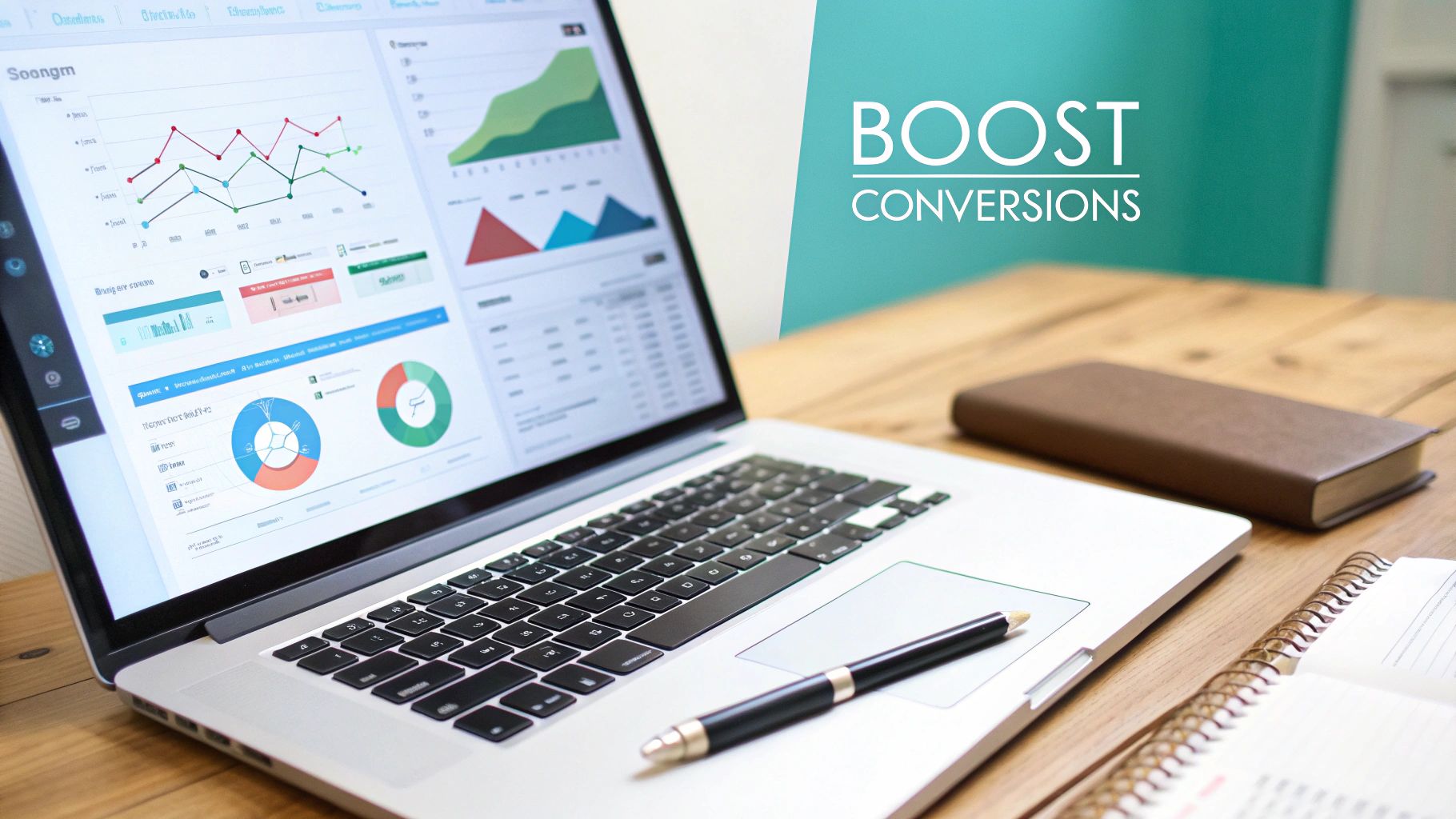
Getting a lead into your system is a huge win, but it’s really just the starting line. The next phase—nurturing—is where many businesses watch their customer acquisition costs (CAC) absolutely balloon. Why? Because manual follow-up isn't just inefficient; it's a massive drain on your most valuable resource: time.
Every single hour your team spends manually sending emails, dialing prospects, or just trying to remember who to contact next is a direct hit to your bottom line. This manual grind inflates your CAC without any guarantee of better results. In fact, it usually leads to slower response times and deals that just fall through the cracks.
This is where automation flips the script. It lets you deliver timely, personal, and relevant messages at scale, guiding prospects toward a decision without needing someone to babysit every single interaction. When you systematize your follow-up, you directly lower your customer acquisition cost by slashing the labor expenses tied to lead nurturing.
Build an Instant Response System
In sales, speed is everything. A lead who has to wait hours—or worse, days—for a reply is a lead you’re probably going to lose. They’ll just move on to a competitor who was ready to engage the second they showed interest. This is where automation delivers its first, most powerful blow to high acquisition costs.
Picture this: a potential client fills out a form on your website asking for a quote on a kitchen remodel. Instead of that lead sitting in an inbox until someone gets around to it, an automated workflow in Nurturely takes over immediately.
Instant SMS Confirmation: Within seconds, the lead gets an SMS: "Hi [First Name], thanks for your interest in our remodeling services! We're reviewing your request now. Can you confirm the best time for a quick 15-min call this week?"
Internal Team Notification: At the same exact time, your sales manager gets a ping with the new lead's details, so everyone is in the loop.
This immediate, two-pronged response accomplishes several things at once. It tells the lead their request was received, it kicks off the conversation professionally, and it buys your team a moment to prepare a thoughtful follow-up. This simple automation stops hot leads from going cold.
An automated welcome sequence isn't just about being efficient. It's about setting a standard of professionalism and responsiveness from the very first touchpoint. You're showing prospects that you're organized and you value their time, which is critical for building trust.
Create Adaptive Nurturing Sequences
Let's be real: not all leads are created equal, so they shouldn't be treated that way. Blasting everyone with the same generic email is a surefire way to get ignored and rack up unsubscribes. The smarter play is to build automated nurturing sequences that adapt based on what a lead actually does. This is how you deliver the right message at the right time.
For example, say you're a lawn care company and you've just captured a new lead. Your automated workflow in Nurturely could play out like this:
Initial Educational Email: The lead gets an email with a helpful guide, like "5 Common Lawn Issues in [Their City] and How to Fix Them."
Behavioral Trigger: The system then watches to see if they click the link.
If they click: They get tagged as "highly engaged." Two days later, they receive a follow-up email with a special offer for a free lawn analysis.
If they don't click: They get a different email four days later with a few customer testimonials and a prompt to check out your service packages.
This adaptive approach keeps your communication relevant. You're not pushing a hard sale on someone who's still just gathering information. Instead, you’re providing value and gently guiding them down the funnel based on their own actions. This level of personalization keeps leads engaged and moving forward—a core piece of any strategy to lower customer acquisition cost by boosting conversion rates.
These same principles are just as powerful for keeping your existing customers happy. You can learn more by checking out how to automate customer support to build loyalty and drive repeat business, which is ultimately the most cost-effective growth strategy there is.
Use Automation to Qualify Leads for Sales
One of the biggest hidden costs in any sales process is the time your team wastes chasing down unqualified leads. When your salespeople are spending their days on calls with people who aren't ready (or able) to buy, your CAC skyrockets.
Automation can act as your first line of defense, filtering your leads so your team only spends time on genuinely hot prospects.
By setting up lead scoring in Nurturely, you can automatically assign points to leads based on their actions—like opening an email, visiting your pricing page, or downloading a case study. Once a lead's score hits a certain threshold, an automation can trigger an internal alert, telling a sales rep it’s time to make a personal call. This simple system transforms your sales process from reactive to proactive, focusing your team's energy where it will have the biggest impact and keeping your acquisition engine lean and mean.
Use Analytics to Cut Wasteful Spending

You can't fix what you can't see. Pouring money into marketing without tracking its performance is like trying to navigate a ship in the fog—you’re moving, but you have no idea if you're heading toward your destination or straight into a reef.
This is exactly where countless businesses hemorrhage money. They drive their acquisition costs through the roof without even realizing why.
The key to getting lean and efficient is to stop guessing and start measuring. A clear view of your marketing analytics turns your strategy from one of hope to one of precision. Using an integrated dashboard, you can finally move beyond a single, simplistic CAC number and really dissect the performance of every single campaign, channel, and lead source.
This is how you find and eliminate wasteful spending to lower your customer acquisition cost for good.
Digging Deeper Than Just the Final CAC
A single customer acquisition cost figure is a useful health check, but it doesn't tell you the whole story. It’s like a doctor telling you that you have a fever without investigating the cause. To make smart decisions, you need to break down the journey that leads to that final number.
This means tracking performance at every single stage of your funnel. The Nurturely analytics dashboard provides this exact clarity, letting you see where your efforts are paying off and where they’re falling flat.
You should be asking tough questions like:
Which ad campaign is generating the most qualified leads, not just the most clicks?
What’s the conversion rate from a new lead to a booked appointment?
How many touchpoints does it take for a lead from Facebook versus a lead from Google to become a paying customer?
Answering these questions reveals the true efficiency of your funnel and shines a light on hidden opportunities for improvement.
Pinpoint Your Most Valuable Lead Sources
Not all leads are created equal. We've all seen it: a referral lead closes in a day with almost no effort, while a lead from a cold ad campaign needs weeks of nurturing and follow-up. Understanding the real value of each lead source is fundamental to optimizing your budget.
Imagine you're a roofing contractor running ads on both Facebook and Google. Your dashboard might spit out something like this:

At first glance, Facebook seems great because it’s delivering more than double the leads. But when you look at the final conversion to paying customers, the story changes completely. Google is delivering actual customers at less than half the cost.
Armed with this data, you can make an intelligent, surgical decision: shift a portion of your Facebook budget over to Google to get more high-quality customers for the same ad spend.
This type of channel-specific analysis is the fastest path to a lower customer acquisition cost. It allows you to systematically defund what isn't working and double down on what is, maximizing the return on every dollar.
This data-driven approach is especially powerful in the digital world. For instance, many B2B SaaS companies have mastered this, helping them achieve a lower combined average customer acquisition cost compared to businesses stuck on older methods. This cost can vary wildly, from around $274 in eCommerce SaaS to $1,450 in the cutthroat Fintech sector, showing just how much your strategy impacts the bottom line.
Ultimately, all these analytical efforts give you the power to get more bang for your ad budget by making informed, data-backed optimizations. You'll move from being a passive advertiser to an active strategist who is in complete control of your marketing ROI.
By embracing analytics, you turn your marketing from a cost center into a predictable, scalable growth engine for your business.
Find Untapped Markets with Geographic Targeting
Sometimes, the simplest way to lower your customer acquisition cost isn't to outspend your rivals—it's to stop competing with them entirely. Too many businesses get sucked into a turf war for attention in the same oversaturated, high-cost markets, and it sends their CAC straight through the roof.
They dump their entire ad budget into major cities where everyone is advertising. This just creates a massive bidding war that only the players with the deepest pockets can ever hope to win.
But there’s a much smarter way to play the game: look where nobody else is looking. Your ideal customers don't just live in New York or L.A. By getting strategic with geographic targeting, you can find and win over customers in less competitive, lower-cost areas where your message actually gets heard and your budget stretches way further.
The Geographic Cost Divide
The cost to get a new customer can swing wildly from one location to the next. This is especially true with digital ads, where it’s all about supply and demand. A single ad click in a major metro area can cost you several times more than the exact same click in a smaller, less crowded city.
This is a massive opportunity staring you right in the face.
If you can serve customers in these lower-cost regions, you can slash your CAC without changing a single thing about your offer or ad creative. You just have to use data to find these goldmines.
The cost of acquiring a new app user shows this perfectly. Getting a user in North America might run you about $5.28, but acquiring that same user in Latin America could be as low as $0.34. A mobile developer could shift their focus and build a huge user base for a fraction of the cost. You can dig into the full data on user acquisition costs to see just how stark these regional differences are.
Testing New Markets Without Breaking the Bank
You don't need a huge, risky investment to see if a new geographic area has potential. With the right tools, you can run small, targeted test campaigns to check for interest and get a read on the potential CAC before you commit serious budget.
Here’s how a service business, like a general contractor, could do this using a platform like Nurturely:
Pinpoint Potential Test Zones: Start by looking at nearby cities or states that have a similar customer profile but feel less saturated.
Launch a Small Geo-Targeted Campaign: Set up a small-budget Facebook or Google ad campaign aimed specifically at those new zip codes. Send all the traffic to a landing page with a killer offer.
Measure Your Initial Cost Per Lead: Jump into Nurturely’s analytics and track how many leads that test campaign is pulling in and, more importantly, what the initial cost per lead (CPL) looks like for that area.
Compare and Pull the Trigger: After a week or two, stack up the CPL from your test market against your main market. If it's a lot lower, you’ve probably just found a profitable new territory to expand into.
This step-by-step process takes all the guesswork out of expansion and lets you make growth decisions based on real numbers.
Your goal isn't just to find cheaper clicks; it's to find areas where your cost to acquire a paying customer is lower. A low CPL is a great leading indicator, but you must track conversions all the way through to the sale to confirm a market's true potential.
Optimizing Campaigns for Local Audiences
Once you've found a promising new market, don't just copy and paste the same generic ads you run everywhere else. Customizing your message for the local crowd can have a huge impact on your conversion rates, driving your acquisition costs down even further.
Mention Local Landmarks: An ad for a roofer might say, "Protecting homes across the [Local County] area."
Reference Local Seasons or Events: A landscaper could run spring cleanup ads that call out a specific regional climate issue, like "Getting your yard ready for the summer heat."
Use Local Testimonials: Nothing builds trust faster. Feature reviews from customers in that specific city or town to create instant social proof.
This kind of hyper-local marketing makes your brand feel like a neighbor, not some faceless national corporation. It shows you actually get the local community, which is a powerful way to connect with customers and make every single marketing dollar work that much harder for you.
Even after you’ve nailed down a solid plan, a few questions always seem to pop up right when it's time to put it all into action. That’s normal. Getting your customer acquisition cost down isn't a "one and done" task—it's a constant process of tweaking, testing, and refining.
Here are some of the most common questions that hit our inbox, with some straight-up answers to help you get moving.
What’s a Good CAC for My Industry?
This is the big one, and the honest answer is: it depends. A "good" CAC is all over the map depending on what you sell. For example, a fashion e-commerce brand might hover around a $129 CAC, but an electronics company could be looking at costs as high as $377. Most service businesses land somewhere in the middle.
But fixating on a universal number is a trap.
The metric that really matters is your LTV to CAC ratio. A healthy business should see a customer's lifetime value (LTV) come in at least three times higher than what you paid to get them. Get to that 3:1 ratio first, then you can start working on pushing it even higher.
How Quickly Can I See My CAC Go Down?
You can see an impact faster than you probably think, especially if you go after the low-hanging fruit first. Something as simple as setting up an instant lead response system with automation can show results within days just by plugging the leaks in your sales process. In the same way, pulling your ad budget from a channel that’s bombing and redirecting it to a winner can lower your blended CAC almost overnight.
Longer-term plays like SEO and content marketing take more time to really move the needle—often six months or more. But the payoff is a sustainable, low-cost way to get customers that keeps delivering for years.
Do I Need a Huge Budget to Lower My CAC?
Absolutely not. In fact, most strategies to lower customer acquisition cost are about working smarter, not spending more. It’s about optimizing what you already have.
Things like tightening up your sales funnel, boosting conversion rates on your landing pages, and building out automated follow-up sequences are all low-cost moves with a massive impact.
These adjustments are designed to squeeze every last drop of value out of the traffic and leads you're already paying for. This is where a platform like Nurturely comes in, making these powerful tools accessible without needing a monster marketing budget or a dedicated tech team to run them.
Is It Better to Focus on Getting New Customers or Keeping Old Ones?
Honestly, that’s a false choice—you have to do both. But if we're talking pure cost, keeping a customer you already have is almost always cheaper than finding a new one. This is why getting your customer retention dialed in is one of the most powerful ways to slash your overall CAC.
Your automated workflows shouldn't just stop once someone buys from you. Keep the conversation going. Use automation to follow up, ask for reviews, and offer loyalty perks. A happy, loyal customer doesn't just buy from you again—they become your best source of free advertising through referrals, which drives your acquisition costs down even further.
Ready to stop wasting money and start getting customers more efficiently? Nurturely Plus gives you all the tools you need in one simple platform—from lead capture and automation to analytics and reporting. See how Nurturely can lower your customer acquisition cost today.
